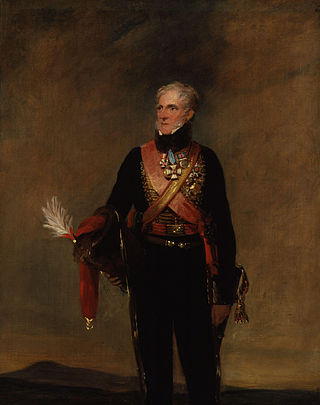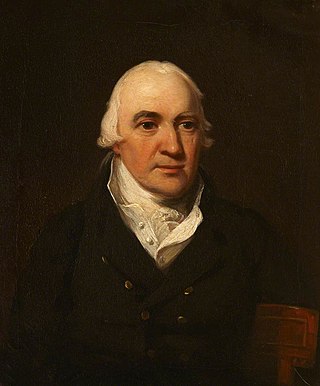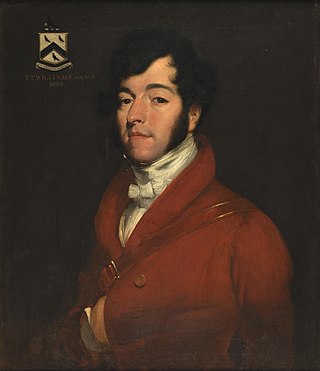Related Research Articles

Henry William Paget, 1st Marquess of Anglesey, styled Lord Paget between 1784 and 1812 and known as the Earl of Uxbridge between 1812 and 1815, was a British Army officer and politician. After serving as a member of parliament for Carnarvon and then for Milborne Port, he took part in the Flanders Campaign and then commanded the cavalry for Sir John Moore's army in Spain during the Peninsular War; his cavalry showed distinct superiority over their French counterparts at the Battle of Sahagún and at the Battle of Benavente, where he defeated the elite chasseurs of the French Imperial Guard. During the Hundred Days he led the charge of the heavy cavalry against Comte d'Erlon's column at the Battle of Waterloo. At the end of the battle, he lost part of one leg to a cannonball. In later life, he served twice as Master-General of the Ordnance and twice as Lord Lieutenant of Ireland.

Marquess of Lansdowne is a title in the Peerage of Great Britain created in 1784, and held by the head of the Petty-Fitzmaurice family. The first Marquess served as Prime Minister of Great Britain.

Marquess of Headfort is a title in the Peerage of Ireland. It was created in 1800 for Thomas Taylour, 2nd Earl of Bective.

Marquess of Anglesey is a title in the Peerage of the United Kingdom. It was created in 1815 for Henry Paget, 2nd Earl of Uxbridge, a hero of the Battle of Waterloo, second in command to the Duke of Wellington. The Marquess holds the subsidiary titles of Earl of Uxbridge, in the County of Middlesex, in the Peerage of Great Britain (1784), Baron Paget, de Beaudesert, in the Peerage of England (1553). He is also an Irish Baronet, of Plas Newydd in the County of Anglesey and of Mount Bagenall in the County of Louth.

Marquess Conyngham, of the County of Donegal, is a title in the Peerage of Ireland. It was created in 1816 for Henry Conyngham, 1st Earl Conyngham. He was the great-nephew of another Henry Conyngham, 1st Earl Conyngham, a member of a family of Scottish descent which had settled during the Plantation of Ulster in County Donegal in Ireland in the early 17th century. The 'founder' of the dynasty in Ireland was The Very Rev. Dr. Alexander Cunningham, Dean of Raphoe. The earlier Henry was a member of both the Irish House of Commons and the British House of Commons and served as Vice-Admiral of Ulster and as Governor of the counties of Donegal and Londonderry. In 1753 he was raised to the Peerage of Ireland as Baron Conyngham, of Mount Charles in the County of Donegal, and in 1756 he was created Viscount Conyngham, in Ireland, also in the Peerage of Ireland. In 1781 he was made Baron Conyngham, of Mount Charles in the County of Donegal, with remainder to his nephew Francis Burton, and Earl Conyngham, of Mount Charles in the County of Donegal, which like the creations of 1753 and 1756 was created with normal remainder to the heirs male of his body. The latter titles were also in the Peerage of Ireland. Lord Conyngham was childless and on his death in 1781 the barony of 1753, the viscountcy and earldom became extinct while he was succeeded in the barony of 1781 according to the special remainder by his aforementioned nephew Francis. He was the eldest son of Mary, sister of the first Earl Conyngham, by her husband Francis Burton. The new 2nd Baron Conyngham, who had earlier represented Killybegs and County Clare in the Irish House of Commons, assumed by Royal licence the surname and arms of Conyngham on succeeding to the titles.

Earl of Drogheda is a title in the Peerage of Ireland. It was created in 1661 for The 3rd Viscount Moore.

Henry Bayly-Paget, 1st Earl of Uxbridge, known as Henry Bayly until 1769 and as Lord Paget between 1769 and 1784, was a British peer.

Henry John Brinsley Manners, 8th Duke of Rutland,, styled Marquess of Granby between 1888 and 1906, was a British peer and Conservative politician.

Henry Paget, 2nd Marquess of Anglesey, styled Lord Paget 1812 and 1815 and Earl of Uxbridge from 1815 to 1854, was a British peer and Whig politician. He served as Lord Chamberlain of the Household between 1839 and 1841.

Plas Newydd is a country house set in gardens, parkland and surrounding woodland on the north bank of the Menai Strait, in Llanddaniel Fab, near Llanfairpwllgwyngyll, Anglesey, Wales. The current building has its origins in 1470, and evolved over the centuries to become one of Anglesey's principal residences. Owned successively by Griffiths, Baylys and Pagets, it became the country seat of the Marquesses of Anglesey, and the core of a large agricultural estate. The house and grounds, with views over the strait and Snowdonia, are open to the public, having been owned by the National Trust since 1976.
This article is about the particular significance of the year 1835 to Wales and its people.
This article is about the particular significance of the year 1825 to Wales and its people.
This article is about the particular significance of the year 1815 to Wales and its people.

Thomas Peers Williams was a British politician, military officer and landowner who was a member of Parliament for Great Marlow from 1820 to 1868. He was Father of the House of Commons from December 1867 to 1868.

Sir Edward Bayly, 1st Baronet was an Irish landowner and politician.

Sir Nicholas Bayly, 2nd Baronet, was a British landowner and Member of Parliament.
Captain William Paget was a British Royal Navy officer and Member of Parliament.
Colonel Nicholas Bayly was a British soldier and Member of Parliament.
Captain Lord William Paget was a British naval commander and Whig politician.
Lord Spencer Stanley Chichester, known as The Honourable Spencer Stanley Chichester from 1775 to 1791, was an Anglo-Irish politician.
References
- ↑ Cokayne, George Edward (1 January 1900). Complete baronetage: Volume V. Dalcassian Publishing Company. p. 351. Retrieved 23 November 2024.
- ↑ Johnston-Liik, E. M. (2002). History of the Irish Parliament 1692-1800: Members of the Irish House of Commons. Ulster Historical Foundation. p. 147. ISBN 978-1-903688-71-7 . Retrieved 23 November 2024.